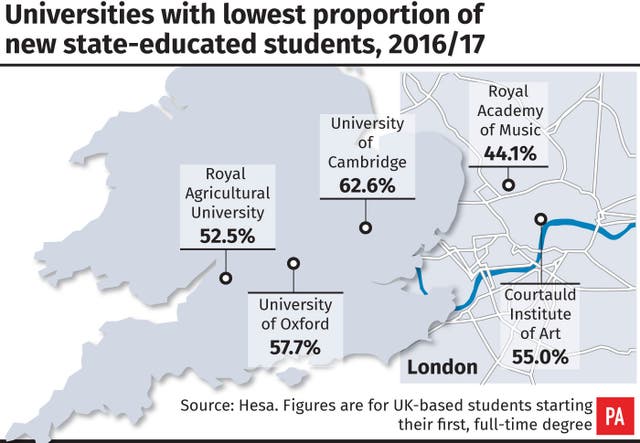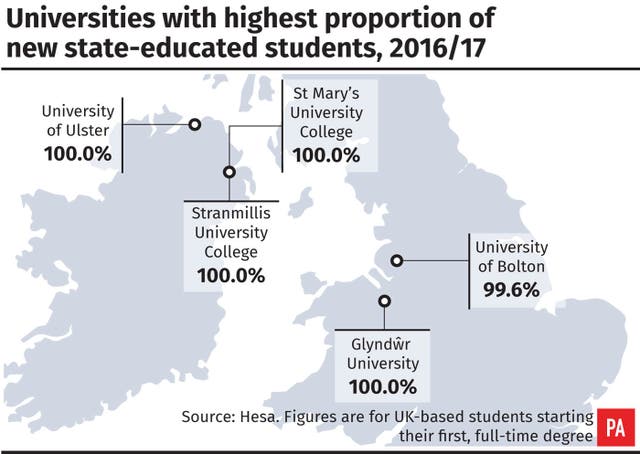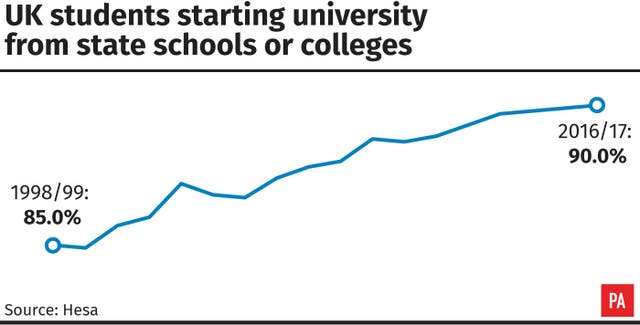
Two in five universities have seen a drop in the proportion of students from state schools, new figures show.
Official statistics indicate significant differences between universities in the proportion of state-educated young people they admitted in 2016/17.
The data also shows that just over a third of the UK’s top institutions have seen a fall in the numbers of students from the state sector.
The figures come amid a continued push by government and the higher education sector to widen participation – encouraging students from all backgrounds to study for a degree.
Overall, nine out of 10 new UK university students in 2016/17 were educated at state schools, figures show.

But a Press Association analysis of the data, published by the Higher Education Statistics Agency (Hesa), shows variations by university.
At some institutions, all UK students who started full-time undergraduate courses in the autumn of 2016 were from state schools, while at others, around half of students were from the state sector.
The data, which covers full-time UK undergraduates, also shows that just over one in 10 (11%) came from disadvantaged neighbourhoods – those areas that traditionally see fewer people going on to higher education.

Overall, the proportion of students from state schools has risen over the last two decades to 90% in 2016/17.
The previous year, 2015/16, the figure was 89.9%, and in 1998/99, it was 85%, according to Hesa figures.
Out of 152 institutions for which there is comparable data, 62 (40.8%) saw a fall in UK state-educated entrants between 2015/16 and 2016/17, while 80 (52.6%) saw a rise and 10 (6.6%) no change.

There were four universities where all new UK students starting their first, full-time degree were state educated.
One was in Wales – Glyndwr University – and the other three in Northern Ireland – St Mary’s University College, Belfast, Stranmillis University College, Belfast and the University of Ulster.
In England, the University of Bolton had the highest proportion of state-educated new students at 99.6%.
At the other end of the scale, the Royal Academy of Music, a small specialist college, had the smallest proportion of state-educated students at 44.1%.
Of the larger universities, Oxford had the smallest proportion of state school entrants at 57.7%, followed by Cambridge at 62.6%.
Both have seen an increase in the proportion of state-educated students, with Oxford up from 55.7% in 2015/16 and Cambridge up from 61.9%.
Overall, in England 90% of UK young university entrants in 2016/17 were state-educated, along with 92.1% in Wales, 86.5% in Scotland and 99.2% in Northern Ireland.
A further breakdown of the 24 Russell Group universities – among the most selective in the country – shows nine (37.5%) had seen a fall in state-educated entrants between the two years, while the other 15 (62.5%) had seen a rise.
Among these leading institutions, Queen’s University, Belfast, had the highest proportion of state-educated pupils at 98.1%, followed by Queen Mary, University of London, at 90.1%.
Sarah Stevens, Russell Group head of policy, said that nearly eight out of 10 young people entering one the Group’s institutions for a full-time first degree come from state schools.
She said: “In England, the overall proportion of state school entrants to Russell Group universities has increased far more quickly over the past few years than for the rest of the sector (up 4.3 percentage points since 2010 compared to 1.8 percentage points for all English universities).
“The proportion of entrants from low participation neighbourhoods also continues to show a steady improvement.
“These figures show we are making real progress, as the Secretary of State has acknowledged.”
She added: “It’s clear that the great efforts our members are making to widen access for those with the potential to progress to an academically selective university are starting to pay off.
“However, we recognise that challenges remain which is why our universities are working with around 8,000 state schools across the country and investing significant sums in mentoring schemes, homework clubs, summer schools and other practical initiatives to help support attainment-raising and encourage even more successful applications.”
Education Secretary Damian Hinds said he was “encouraged” by the proportions of university students from state schools and disadvantaged areas.
“Of course there is still more to do,” he added.
“That is why we have introduced major reforms through the Higher Education and Research Act, including the Transparency Duty which will require all universities to publish data broken down by gender, ethnicity and socio-economic background, shining a light on institutions that need to do more to widen access.”


Comments: Our rules
We want our comments to be a lively and valuable part of our community - a place where readers can debate and engage with the most important local issues. The ability to comment on our stories is a privilege, not a right, however, and that privilege may be withdrawn if it is abused or misused.
Please report any comments that break our rules.
Read the rules hereLast Updated:
Report this comment Cancel